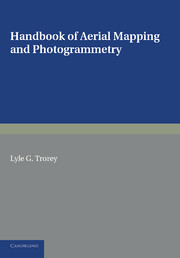Book contents
- Frontmatter
- Dedication
- FOREWORD
- PREFACE
- Contents
- LIST OF TABLES
- Bibliography
- Notation
- CHAPTER 1 PERSPECTIVE PRINCIPLES
- CHAPTER 2 MEASUREMENT OF ANGLES FROM OBLIQUES
- CHAPTER 3 PERSPECTIVE GRID AND FOUR-POINT METHODS
- CHAPTER 4 MEASUREMENT OF HEIGHT FROM A SINGLE OBLIQUE
- CHAPTER 5 VERTICALS: FUNDAMENTAL CONSIDERATIONS OF COVER, PARALLAX AND STEREOSCOPY
- CHAPTER 6 PARALLAX AND ELEVATION CALCULATIONS
- CHAPTER 7 RADIAL-LINE TRIANGULATIONS, GRAPHICAL AND MECHANICAL
- CHAPTER 8 RECTIFICATION MEANS
- CHAPTER 9 SUBDIVISIONS OF AN AIR SURVEY MAPPING OPERATION
- CHAPTER 10 PRINCIPLES OF STEREOSCOPIC PLOTTING INSTRUMENTS
- CHAPTER 11 THE MULTIPLEX PROJECTOR
- APPENDIX 1 STANDARD MAPPING PROCEDURE ROYAL CANADIAN ENGINEERS
- APPENDIX 2 MULTIPLEX AND STEREOPLANIGRAPH: CONSIDERATIONS GOVERNING MINIMUM CONTOUR INTERVAL
- APPENDIX 3 THE KELSH PLOTTER
- INDEX
CHAPTER 2 - MEASUREMENT OF ANGLES FROM OBLIQUES
Published online by Cambridge University Press: 05 June 2016
- Frontmatter
- Dedication
- FOREWORD
- PREFACE
- Contents
- LIST OF TABLES
- Bibliography
- Notation
- CHAPTER 1 PERSPECTIVE PRINCIPLES
- CHAPTER 2 MEASUREMENT OF ANGLES FROM OBLIQUES
- CHAPTER 3 PERSPECTIVE GRID AND FOUR-POINT METHODS
- CHAPTER 4 MEASUREMENT OF HEIGHT FROM A SINGLE OBLIQUE
- CHAPTER 5 VERTICALS: FUNDAMENTAL CONSIDERATIONS OF COVER, PARALLAX AND STEREOSCOPY
- CHAPTER 6 PARALLAX AND ELEVATION CALCULATIONS
- CHAPTER 7 RADIAL-LINE TRIANGULATIONS, GRAPHICAL AND MECHANICAL
- CHAPTER 8 RECTIFICATION MEANS
- CHAPTER 9 SUBDIVISIONS OF AN AIR SURVEY MAPPING OPERATION
- CHAPTER 10 PRINCIPLES OF STEREOSCOPIC PLOTTING INSTRUMENTS
- CHAPTER 11 THE MULTIPLEX PROJECTOR
- APPENDIX 1 STANDARD MAPPING PROCEDURE ROYAL CANADIAN ENGINEERS
- APPENDIX 2 MULTIPLEX AND STEREOPLANIGRAPH: CONSIDERATIONS GOVERNING MINIMUM CONTOUR INTERVAL
- APPENDIX 3 THE KELSH PLOTTER
- INDEX
Summary
Classification of Air-Survey Photographs
Ground-Survey Photographs. These are usually taken with the optical axis accurately horizontal, and the plate is accordingly vertical. They are used infrequently in combination with air photography, but are valuable for extension of control. Their treatment is briefly discussed herein.
High (or horizon) Obliques. Photographs taken with the optical axis tilted to include the visible horizon are called high obliques. The expression ‘high’ has nothing to do with the altitude of the aircraft; it refers to the camera being pointed high enough to include the horizon. Ordinarily when obliques are mentioned, it is high obliques which are thought of. Horizon obliques is a better designation.
Low (non-horizon)Obliques. AS the optical axis is further depressed from the horizontal the photo position of the horizon rises. When the horizon no longer appears on the format the photography is called low oblique. It is preferable to call such photographs non-horizon obliques. ‘Verticals’ too tilted to be dealt with by the radial line method may be called near verticals; they are seldom deliberately so taken for survey purposes but result from a variety of causes, the chief of which in wartime is the impracticability of maintaining standards of survey flying in the face of opposition from enemy aircraft and anti-aircraft batteries. In peacetime, too, such photographs may result in a variety of cases (e.g. in exploratory surveys). They are capable of utilization by various simple methods, and have a specific application in the determination of heights of ground objects (i.e. trees).
For military reconnaissance purposes a three-camera set-up is frequently used, the cameras being set at (approximately) 15° tilt to port, 15° to starboard, and vertical. This setting results in split verticals with tilts which may amount to 20 or 30°. Photography of this kind is sometimes the best that is available for military mapping. Split verticals are also used in forest inventory photography.
Verticals. The camera axis is vertical, or nearly so. Angle θ of fig. 1 is zero to 3 or 4°. It is stated that if tilts can be limited to 2° and the relief of the ground does not vary by more than 10% of the altitude of the flight, then the error so introduced is negligible for radial-line methods of plotting.
- Type
- Chapter
- Information
- Handbook of Aerial Mapping and Photogrammetry , pp. 7 - 22Publisher: Cambridge University PressPrint publication year: 2013



